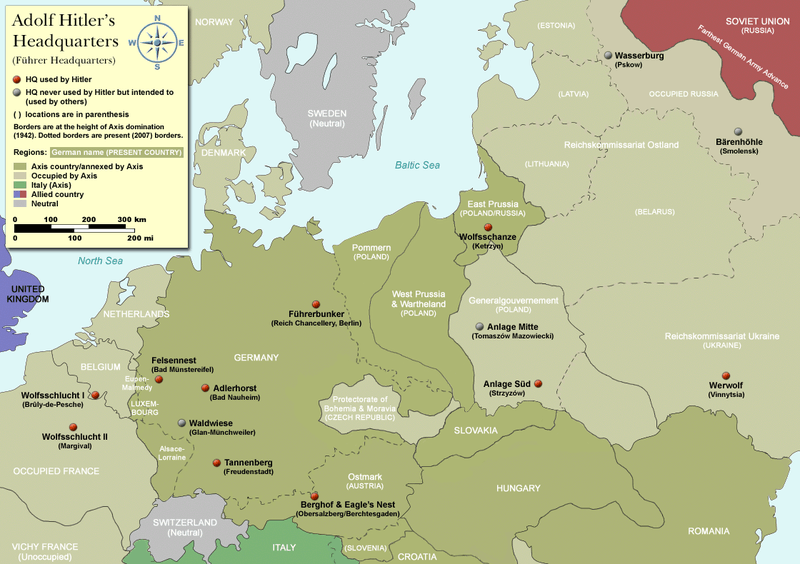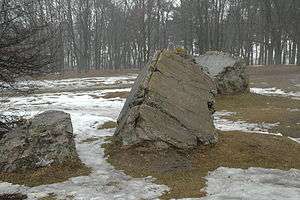Werwolf (Wehrmacht HQ)
| Werwolf | |
|---|---|
| Wehrmacht HQ | |
|
Ruins of Hitler's headquarters Werwolf near Vinnytsia, Ukraine | |
 Location within Ukraine | |
| General information | |
| Type | Blast resistant concrete bunker |
| Town or city |
Wervolf Forest Vinnytsia |
| Country | Ukraine |
| Coordinates | 49°18′30″N 28°29′36″E / 49.30833°N 28.49333°ECoordinates: 49°18′30″N 28°29′36″E / 49.30833°N 28.49333°E |
| Elevation | 243 m (797 ft) |
| Construction started | November 1, 1941 |
| Completed | June 1942 |
| Destroyed | March 1944 |
| Owner | Third Reich |
| Technical details | |
| Structural system | Steel-reinforced concrete |
| Design and construction | |
| Architecture firm | Organisation Todt |

Führerhauptquartier Werwolf was the codename used for one of Adolf Hitler's World War II Eastern Front military headquarters located in a pine forest about 12 kilometres (7.5 mi) north of Vinnytsia, in Ukraine, which was used between 1942 and 1943. It was one of a number of Führer Headquarters throughout Europe, and the most easterly ever used by Hitler in person.
Naming
The name is derived from Werwolf, which is German for werewolf.[1] The naming scheme is in accord with other code-names given to Führerhauptquartiere during the Second World War, such as Wolfsschanze. Several were named for Hitler himself, whose nickname was Wolf, an old German form of Adolf.[2][3]
Headquarters
The complex was located in a pine forest, about 12 kilometres (7.5 mi) north of Vinnytsia in Ukraine, between the villages of Stryzhavka and Kolo-Mikhailovka on the Kiev highway. It was built between December 1941 and June 1942 under top secret conditions. The location may have been influenced by the Nazis' proposed trans-European highway to the Crimean Peninsula, which would have connected with the site. The Wehrmacht had its regional headquarters in Vinnytsia, and the Luftwaffe had a strong presence at their airbase in Kalinovka, about 20 km away.
Hitler's accommodation at Werwolf consisted of a modest log cabin built around a private courtyard with its own concrete bunker. The rest of the complex consisted of about 20 wooden cottages and barracks and up to three "B" class bunkers, surrounded by ring of barbed wire and ground defensive positions connected by underground tunnels. A couple of observation points were set up on platforms in the oak trees surrounding the pine forest. The area was surrounded by a defensive strip of bunkers, anti-aircraft guns and tanks, as well as anti-tank ditches and minefields. [4]
There was a tea house, a barber shop, a bathhouse, a sauna, a cinema and even an open swimming pool for the inhabitants' use. Although this pool was primarily intended for Hitler, he never once swam in it. The facility also contained a large vegetable garden organised by the German horticultural company Zeidenspiner to provide Hitler with a secure supply of food. Two artesian wells supplied the site with water, and the site had its own power generation facilities.
The bunkers were constructed by Organisation Todt using local Ukrainian workers, forced labour but mainly Soviet prisoners of war. Many of the workers were subsequently murdered to maintain the secrecy of the site.[5]
The complex was served by a daily three-hour flight connection from Berlin to the airfield in nearby Kalinovka. There was also a regular train connection from Berlin-Charlottenburg to "Eichenbein" station at Werwolf. The ride took 34 hours.
During his Eastern campaign, Adolf Hitler lived mainly at FHQ Wolfsschanze (near Rastenburg, East Prussia); he stayed at FHQ Werwolf only three times:
- 16 July to 30 October 1942. The weather was hot, up to 45 °C, and the bunkers were humid. Hitler caught severe influenza, with a temperature running up to 40 °C. In this condition he gave his fateful decree no. 45 and split his army group "South" into two parts, trying to reach both Stalingrad and the Caucasus oil fields simultaneously.
- 19 February to 13 March 1943.
- 27 August to 15 September 1943.
History
The Nazis destroyed the site, including mining access to the underground complex, on abandoning the region. The site was examined after the Nazi departure in March 1944 under the orders of Joseph Stalin, but no documentation was found. The Soviet Union took steps to permanently seal the underground parts of the complex.
Today only the swimming pool and concrete fragments remain visible on the site, which is an open recreation area. Nearby is a memorial to the thousands of labourers and others buried by the Nazis in gravepits at Stryzhavka.
See also
References
- ↑ The Nazis also used the term Werwolf as a codename for clandestine resistance groups which were intended to carry out guerrilla attacks against the occupying forces towards the end of World War II.
- ↑ Antony Beevor (2001). Stalingrad. London: Penguin Books. p. 97. ISBN 0-14-100131-3.
As an alternative to Wolfsschanze at Rastenburg, it was code-named Werwolf. (The word Wolf, an old German version of Adolf, clearly gave the Führer an atavistic thrill.)
- ↑ John Toland (1978). Adolf Hitler. New York: Ballantine Books. p. 978. ISBN 0-345-27385-0.
Hitler moved his headquarters deep into the Ukraine […] a few miles northeast of Vinnitsa. Christened Werwolf by himself, it was an uncamouflaged collection of wooden huts located in a dreary area.
- ↑ Matthias Uhl and Henrik Eberle (1978). The Hitler Book: The Secret Report by His Two Closest Aides. London: John Murray. p. 400. ISBN 978-0719554995.
When Hitler arrived at Werwolf Colonel Thomas, the HQ commander, was waiting for him... Thomas took Hitler over the terrain around the HQ and showed him the security measures. The area was surrounded by a defensive strip of bunkers, anti-aircraft guns and tanks, as well as anti-tank ditches and minetields. Rattenhuber Hitler’s head of security, had formed a special group of RSD men whose job was to watch the approaches to the HQ and to keep an eye on the local population.
- ↑ Matthias Uhl and Henrik Eberle (1978). The Hitler Book: The Secret Report by His Two Closest Aides. London: John Murray. p. 400. ISBN 978-0719554995.
Hitler gave an approving nod and asked, ‘Who built the camp?’ Thomas [the HQ commander] answered, ‘Mostly Russians prisoners from the camps.’ Hitler‘s face darkened. He told Thomas, ‘They must all be shot. There is not a moment to lose. They know too much about my HQ.’ Thomas clicked his heels and answered, ‘At your command, my Fuhrer’ He turned on his heels and went.
Bibliography
- Zeidler, Zeigert, Die Führerhauptquartiere.
| Wikimedia Commons has media related to Werwolf. |
